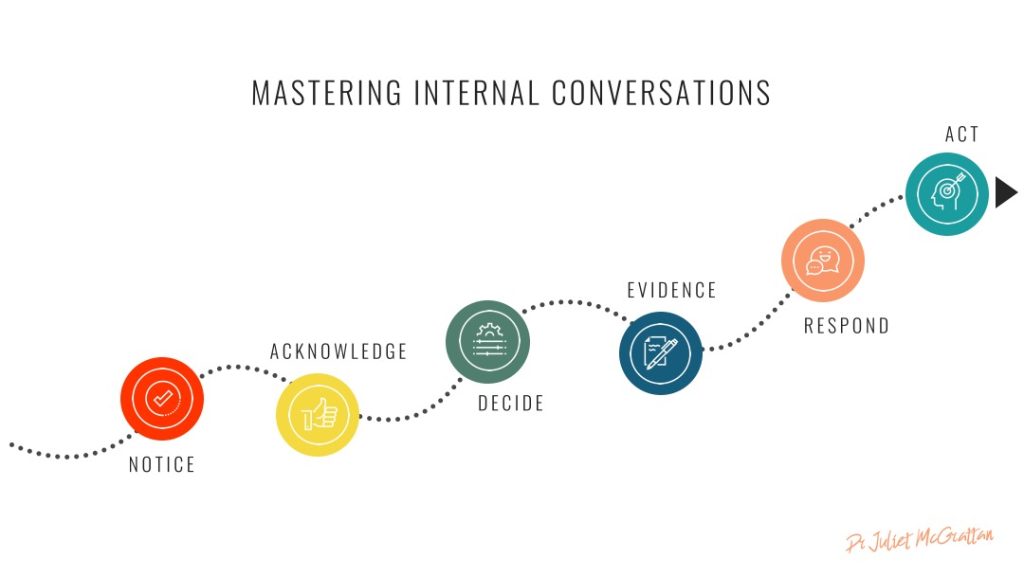I don’t know about you but I have a lot of conversations with myself – in my head. This is particularly the case when it comes to running. There’s often a huge dialogue about whether I should run, when I should run and what type of run I should do. And then, once I’m running, there’s an almost constant narrative about whether I’m going to fast or too slow, whether I should stop, give up and so it goes on!
One part of me is the goody and wants me to run and continue to run, the other is the baddie and tries to sabotage all my efforts. I think this is fascinating. Where does this all come from? Which one is really me? How can I use these conversations for the biggest gain?
Why do the internal debates happen?
I’m not a neuroscientist or psychologist so I certainly don’t have all the answers to these questions. There may not actually be concrete explanations for them all. No doubt what goes on in everyone’s heads is unique to them. The body likes to stay constant and comfortable. Often these internal conversations intensify when we’re stepping out of our comfort zone or trying something new. I feel they can also get louder at times of change such as the menopause transition.
Negative thoughts and menopause
My last blog ‘Running, Menopause and (lack of) Confidence’ resonated with lots of women. Part of that feeling of reduced confidence for me has been more negative narration that just gets so tiring to constantly counteract. After a while it becomes normal and you start to believe that that’s you. When you’re running, or wanting to run, the baddie keeps winning the day and gradually you start to believe that you’re not the runner you were and that running doesn’t matter as much anymore. It can be very demoralising, tiring and ultimately put you off running.
What can you do?
What can you do if this is happening to you? I just wanted to share what I’ve observed and what helps me in case it might help you too. I’ve tried to break down my thought processes and work out how I respond to these negative thoughts. I’ve created a framework and this is how it works for me.
1. Notice
So many of our thoughts happen without us noticing them. We just ‘feel’ a certain way and act with little processing. For example, you’re running along and even though you haven’t finished what you set out to do, you feel tired and stop. Then you wish you hadn’t because you know you really do have more energy and didn’t need to quit. If, however you were to notice the thought and identify that it was the baddie speaking, you would have time to consider it and decide on what your action should be. The first step is to spot when these things are happening and not to act automatically. Noticing and tuning in to the narrative takes practice.
2. Acknowledge
Although I can quite quickly dismiss much of what the baddie is saying, I think it’s important to acknowledge it and listen. This is after all, part of me and if I just ignore it, there’s a risk it will go on and on. All our thoughts and feelings are valid. It’s equally important to listen to the goody too!
3. Decide
Sometimes a short sharp word is needed, other times there needs to be more of a negotiation. I just make a decision as to whether this is worth even discussing with myself!
When it’s a recurring thought that I know has popped up lots of times before, a quick, ‘OK, Doubt, I knew you might appear, you’re not needed right now, get back in your box.’ will do the trick. There’s no discussion, I quickly put that thought in its place and move on.
If it’s clear to me that this could be the truth, I’m not feeling strong or a thought keeps coming back, then a different approach is needed. When I realise it’s going to take more than just a quick, sharp retort to move forwards, I decide to solve the issue and move on to number four.
4. Evidence.
The thoughts I have are often irrational and unhelpful. They don’t reflect the reality. One thing which I’ve found really useful is to look at the evidence. So for example, if my thought is that I’m going to fail at my long run and not be able to finish it, I would question what evidence there actually is for that. My goody voice will be able to speak up and remind me that I have done lots of long runs, that my training has been gradually increasing, that I’m fit and well, that I can take it steady. There’s no reason why this one will fail. I am experienced and well prepared and the evidence supports that this will go well.
Similarly, If my baddie voice is telling me to stop running because I’m too tired to keep going, my goody voice will do a body scan and check in on my feet, my posture, my breathing, it will remind me and tell the baddie that I’m in good shape that I’ve fuelled well and can keep going, no problem. There’s nothing to suggest I need to stop after all.
5. Respond
Next it’s working out what you need in that moment. Do you need a kind friend to give you an imaginary hug and tell you you’re doing great? Do you need a Coach to motivate and encourage you and remind you of what your goal is? Do you need an advocate to stand up for you or a protector to shout sternly at the baddie and let them know they aren’t wanted? Every situation is different. That’s the great thing though, your goody can be flexible and adapt and change to help you, it can be a coach or mentor, a friend or teacher. You can bring in any member of your internal team to sort this out. You’ll get to know what you need and who to call on in each moment.
6. Act
Trust yourself. Trust that your goody can deliver the words you need and then act on them. Sometimes I can be a bit defiant and if the baddie has been trying to convince me to slow down I’ll go a bit faster to prove a point! Be confident in what you’ve told yourself and take the next step.

That’s a little insight into what goes on in my head! I would love to know if these conversations are in any way similar to yours. It’s only really in recent years that I’ve been observing them more and using them to help me perform better, in running and in life generally. With the menopausal lack of confidence, the baddie voice has turned in to a bit of a choir at times, it’s taken a lot to drown it out and for the goody be heard over the noise! It all takes practice though. Expecting only positive thoughts is unrealistic. Mastering these internal conversations is so important for moving forward with confidence.
If you’ve enjoyed this blog and are finding the menopause is affecting your confidence and your running then have a look at my Run Through the Menopause course. In it I tackle mindset and share ways to grow your confidence alongside looking at how to tackle the problems and challenges that the menopause can bring to your running.
Featured Image: Gerd Altmann from Pixabay. Framework image: drjulietmcgrattan.com








I think I’ve had these conversations ever since I started running. I’ve been in tears at the side of the road phoning a friend because I wanted to give up. They persuaded my otherwise. I’m not sure if they have increased of late, but I have been running less and less so I think that if I try to fit in more runs, no matter how short that will help.
It’s so hard sometimes isn’t it. I’ve certainly found signing up for something and training for it has helped my running conifdence ans reduced te doubt.